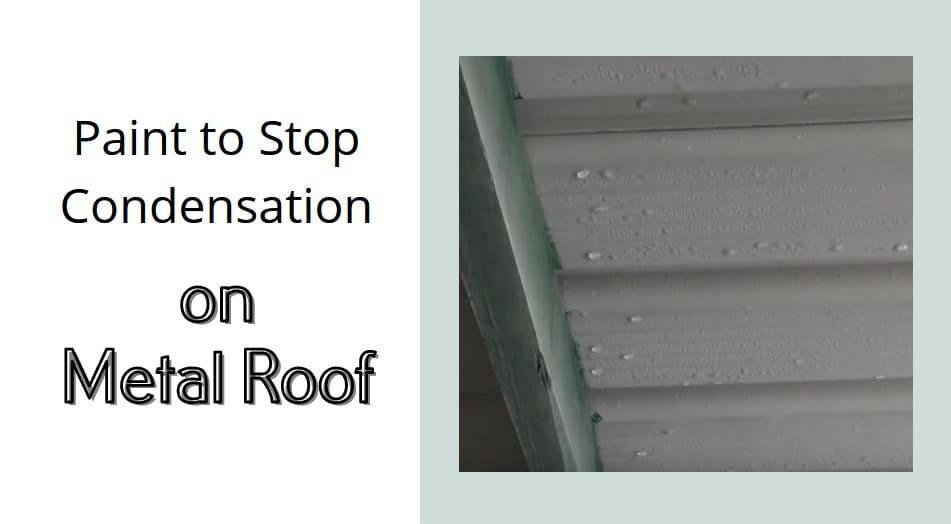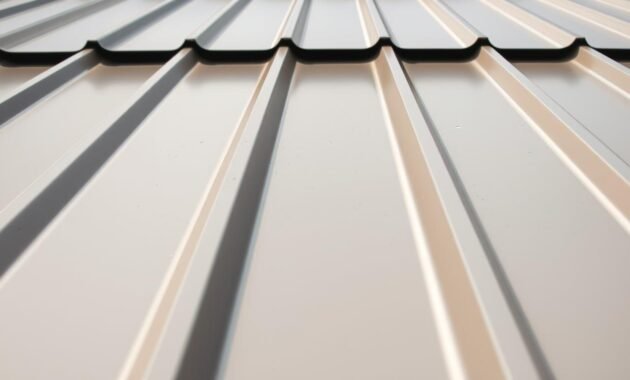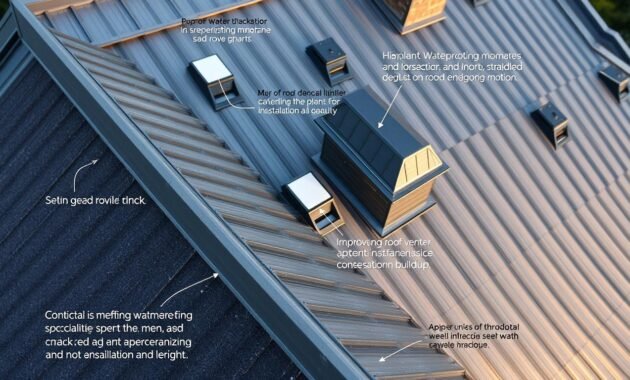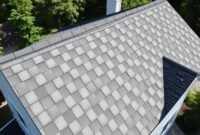Metal roofs face a silent enemy: condensation. I’ve seen many buildings damaged by moisture that could have been stopped. Warm air meets cold metal, creating water droplets that harm your roof.
It’s not just about a few water droplets. Using paint to stop condensation can protect your roof from big damage. Moisture causes rust and damage, leading to costly repairs.
But there’s a solution. Special coatings can protect your roof from moisture. This keeps your roof strong and safe for years to come.

Understanding Metal Roof Condensation Formation
Metal roofs face unique challenges with moisture. As a roofing expert, I’ve seen many cases where metal roofs get wet. This happens because of many environmental factors.
Controlling condensation starts with knowing why moisture builds up. It happens when warm, humid air meets a cooler surface. This creates the perfect spot for water droplets to form.
Temperature Differences and Condensation Process
Temperature changes are key to preventing roof moisture. When warm air inside meets the cooler roof, water vapor turns into droplets. This is common in:
- Warehouses
- Agricultural buildings
- Garages
- Storage facilities
Role of Humidity in Condensation Development
Humidity is also very important. More moisture in the air means more chance of water droplets on metal. When humidity is over 60%, the risk of condensation is highest.
Common Areas Affected by Roof Condensation
Some areas are more likely to have condensation problems. These include:
- Roof edges
- Interior structural joints
- Areas with poor ventilation
- Regions with big temperature changes
Knowing these factors helps owners manage moisture better on their metal roofs.
Why Metal Roofs Are Particular Susceptible to Moisture Problems
Metal roofing needs special care because of its unique heat properties. Unlike other roofs, metal roofs are more likely to get moisture damage. This is because metal cools down fast when it gets cold, making it a perfect spot for moisture to build up.
There are a few main reasons why metal roofs are more likely to have moisture issues:
- Rapid heat dissipation causing quick temperature fluctuations
- Minimal insulation capabilities compared to other roofing materials
- Higher thermal conductivity which accelerates condensation
- Increased susceptibility to temperature differentials
To stop roof corrosion, it’s important to understand these special traits. Metal roofs lose heat and cold quickly, which makes them more likely to get moisture. This fast change in temperature makes metal roofs very vulnerable to moisture problems.
| Roofing Material | Thermal Mass | Condensation Risk |
|---|---|---|
| Metal Roof | Low | High |
| Asphalt Shingles | Medium | Low |
| Clay Tiles | High | Very Low |
The design of metal roofs in buildings can make moisture problems worse. Buildings with bad ventilation or high humidity are at a higher risk. By knowing these risks, property owners can take steps to protect their roofs from damage.
Read also: Common Metal Roof over Shingles Problems
The Impact of Condensation on Structural Integrity
Keeping roofs dry is key to keeping buildings strong. Condensation can harm the structure and cause expensive fixes if not stopped.
Moisture on metal roofs can cause big problems. It can lead to fast damage to building materials.
Immediate Effects on Building Materials
Condensation starts with a few big issues:
- Rapid rust formation on metal surfaces
- Potential damage to stored equipment and inventory
- Creation of slippery surfaces that pose safety risks
- Reduced thermal efficiency of the building
Long-term Structural Damage Concerns
Long-term moisture damage is serious. Waterproof roof paint helps prevent these problems.
| Structural Damage Type | Potential Consequences |
|---|---|
| Metal Corrosion | Weakened structural support |
| Mold Growth | Health hazards and material degradation |
| Insulation Compromise | Increased energy costs |
Cost Implications of Unchecked Condensation
Ignoring condensation can cost a lot. Repairs and replacements can be very expensive. It’s cheaper to prevent problems than to fix them.
Using good waterproof roof paint and managing moisture well can save buildings. It keeps them safe from moisture damage.
Paint to Stop Condensation on Metal Roof

Protecting metal roofs from moisture damage is key. Paint for condensation is a smart way to fight moisture problems. Anti-condensation coating is a strong defense against water buildup.
Moisture-resistant paint creates a barrier to stop water droplets on metal. This coating does several things:
- Regulates surface temperature
- Absorbs excess moisture
- Prevents water from touching metal
- Reduces thermal bridging effects
Choosing the right anti-condensation coating is important. Roofers look for paint with good thermal insulation and fits well with metal surfaces. Some paints can even lower the surface temperature to prevent condensation.
Using top-notch paint for condensation prevention saves money on repairs. These coatings protect against moisture damage and make metal roofs last longer.
Homeowners and building managers can greatly improve their roof’s performance with the right paint. The right coating is a strong shield against moisture damage and structural problems.
Types of Anti-condensation Coatings Available
Choosing the right anti-condensation solutions is key to protecting metal roofs from moisture damage. I’ve looked into the most effective thermal barrier coatings to guide your choice.
There are many specialized coatings on the market to fight condensation and safeguard metal roofs. Knowing about these options can greatly enhance your roof’s life and function.
Water-based Anti-condensation Solutions
Water-based anti-condensation solutions are eco-friendly for controlling moisture. They usually have:
- Low volatile organic compound (VOC) content
- Easy application and cleanup
- Quick drying times
- Excellent moisture absorption properties
Thermal Barrier Coatings
Thermal barrier coatings are a modern solution to stop condensation. They work by:
- Regulating surface temperature
- Reducing temperature differences
- Creating a moisture-resistant surface
- Providing enhanced insulation
Advanced Moisture-resistant Formulations
The newest moisture-resistant coatings blend various protective technologies. Look for products with:
- Ceramic-enhanced materials
- Nano-technology infusion
- Multi-layer protection systems
- Extended durability
Choosing the right thermal barrier coating depends on your specific needs and environment. Talking to a professional can help find the best anti-condensation solution for your metal roof.
Proper Surface Preparation Techniques
Getting your metal roof ready for anti-condensation paint is key for good protection. I’ll show you how to make sure your roof is perfect for painting.
First, clean and check your metal roof before painting. Start by making a clean, smooth surface. This lets the paint stick well.
- Remove dirt, debris, and loose rust using wire brushes
- Clean surface with industrial-strength metal degreaser
- Sand down corroded or damaged metal areas
- Repair any existing structural damage
- Ensure complete surface dryness before painting
Professional prep involves important steps. Use special cleaners made for metal. These remove dirt that can stop paint from sticking.
Read also: Rust Treatment For Metal Roofs
| Preparation Step | Purpose | Recommended Tools |
|---|---|---|
| Degreasing | Remove oil and industrial residues | Industrial metal cleaner, soft cloths |
| Rust Removal | Eliminate corrosion and prevent future damage | Wire brush, sandpaper, rust converter |
| Surface Priming | Enhance paint adhesion and protection | Metal-specific primer, roller, brush |
Ignoring prep can ruin your roof’s protection plan. Spend time on cleaning and priming for lasting results and better moisture control.
Application Methods for Maximum Effectiveness
Applying anti-condensation coating to a metal roof needs care and the right method. Doing it right can protect your building’s structure well.
Essential Tools and Equipment
Before starting, get these important tools:
- High-quality paint roller with extended handle
- Professional-grade paint sprayer
- Paint brushes for detailed areas
- Protective safety gear (gloves, goggles, respirator)
- Drop cloths or protective sheeting
Step-by-Step Application Process
- Clean the metal roof surface thoroughly
- Repair any existing damage or rust spots
- Ensure surface is completely dry
- Apply primer if recommended by manufacturer
- Use consistent, even strokes during application
- Maintain recommended paint thickness
Drying and Curing Considerations
The success of your coating depends on proper application and drying. Most coatings need specific conditions to work best.
| Condition | Recommended Setting |
|---|---|
| Temperature Range | 50-85°F (10-29°C) |
| Humidity Level | 40-60% |
| Initial Drying Time | 4-6 hours |
| Complete Cure Time | 24-48 hours |
Let enough time pass between coats. Avoid applying in extreme weather. Proper technique ensures your coating works well for years.
Additional Preventive Measures Beyond Paint

Preventing roof moisture is more than just using anti-condensation paint. I’ve found important ways to keep metal roofs safe from moisture. To control condensation, we need to tackle moisture from all angles.
Understanding your building’s environment is the first step. A good plan includes several key parts:
- Improve ventilation systems
- Install high-quality insulation
- Apply vapor barriers
- Conduct regular roof inspections
Ventilation is key in controlling condensation. Good airflow helps keep temperature and humidity in check. This reduces moisture buildup. It’s wise to talk to a roofing expert to see how to improve your ventilation.
| Prevention Method | Effectiveness | Cost Range |
|---|---|---|
| Improved Ventilation | High | $500 – $2,500 |
| Advanced Insulation | Very High | $1,000 – $5,000 |
| Vapor Barrier Installation | Moderate to High | $750 – $3,000 |
Insulation is another vital defense against condensation. It acts as a thermal barrier, reducing temperature differences that lead to moisture. Choose insulation made for metal roofs for the best protection.
Vapor barriers add an extra layer of protection. They block moisture, keeping it from reaching your roof’s structure. It’s important to install them correctly for the best results.
Maintenance Requirements After Paint Application
Protecting your metal roof doesn’t stop after painting. Keeping up with metal roofing maintenance is key. This ensures your roof stays in good shape for years.
Read also: How to Install Gutter Guards for Metal Roof
Regular checks are essential for roof care. I suggest inspecting your roof twice a year, in spring and fall. Look for signs like paint fading, peeling, moisture, and rust.
- Areas of paint discoloration or fading
- Small cracks or peeling in the coating
- Signs of moisture accumulation
- Rust spots or corrosion beginnings
Cleaning is also important. Use a soft brush and gentle cleaner to remove dirt and debris. Avoid harsh chemicals that can harm your paint.
Experts say to reapply anti-condensation paint every 5-7 years. The exact time depends on your area, roof exposure, and paint quality. Early recoating can save you from costly repairs.
By taking the time for regular maintenance, you’ll keep your metal roof strong. This will also make it last longer.
Conclusion
Dealing with metal roof condensation doesn’t have to be hard. Using paint to stop condensation on metal roofs can greatly reduce moisture risks. Studies show that a mix of protective methods is the best way to avoid damage.
Understanding how moisture forms and acting fast is key. Using special paint, improving air flow, and adding insulation can help a lot. These steps create a strong plan to manage moisture, saving money and keeping your roof in good shape.
Homeowners and building managers should check their roofs often and keep them up. The right steps can turn a metal roof into a strong, lasting shield. With the right care, your metal roof will stay dry and strong against moisture.
Protecting your metal roof is all about being proactive. Knowing the risks of condensation and using the right solutions can protect your property. Investing in the right paint and upkeep can lead to a longer-lasting roof and lower repair costs.




